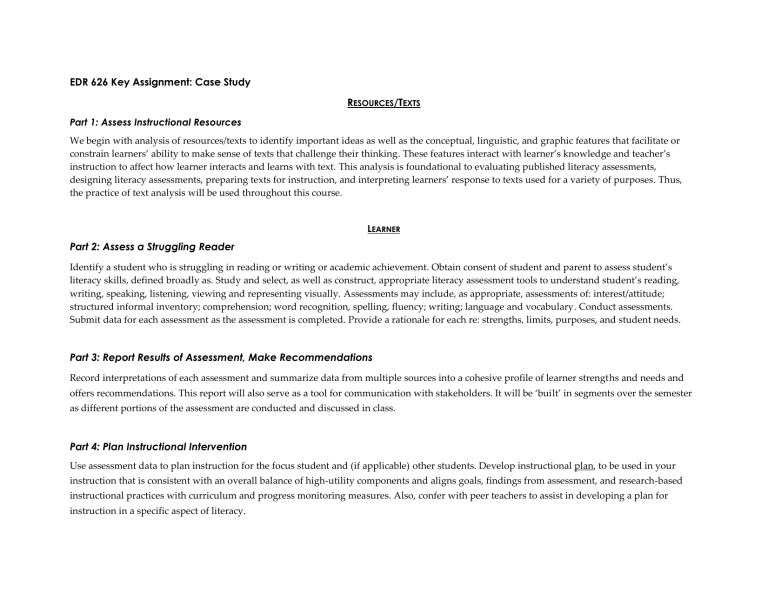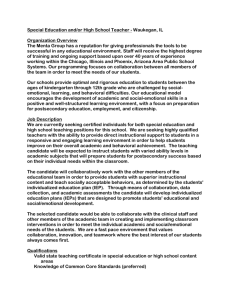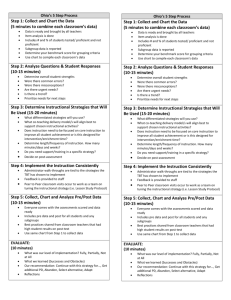Common Course Assessment

EDR 626 Key Assignment: Case Study
R
ESOURCES
/T
EXTS
Part 1: Assess Instructional Resources
We begin with analysis of resources/texts to identify important ideas as well as the conceptual, linguistic, and graphic features that facilitate or constrain learners’ ability to make sense of texts that challenge their thinking. These features interact with learner’s knowledge and teacher’s instruction to affect how learner interacts and learns with text. This analysis is foundational to evaluating published literacy assessments, designing literacy assessments, preparing texts for instruction, and interpreting learners’ response to texts used for a variety of purposes. Thus, the practice of text analysis will be used throughout this course.
L EARNER
Part 2: Assess a Struggling Reader
Identify a student who is struggling in reading or writing or academic achievement. Obtain consent of student and parent to assess student’s literacy skills, defined broadly as. Study and select, as well as construct, appropriate literacy assessment tools to understand student’s reading, writing, speaking, listening, viewing and representing visually. Assessments may include, as appropriate, assessments of: interest/attitude; structured informal inventory; comprehension; word recognition, spelling, fluency; writing; language and vocabulary. Conduct assessments.
Submit data for each assessment as the assessment is completed. Provide a rationale for each re: strengths, limits, purposes, and student needs.
Part 3: Report Results of Assessment, Make Recommendations
Record interpretations of each assessment and summarize data from multiple sources into a cohesive profile of learner strengths and needs and offers recommendations. This report will also serve as a tool for communication with stakeholders. It will be ‘built’ in segments over the semester as different portions of the assessment are conducted and discussed in class.
Part 4: Plan Instructional Intervention
Use assessment data to plan instruction for the focus student and (if applicable) other students. Develop instructional plan, to be used in your instruction that is consistent with an overall balance of high-utility components and aligns goals, findings from assessment, and research-based instructional practices with curriculum and progress monitoring measures. Also, confer with peer teachers to assist in developing a plan for instruction in a specific aspect of literacy.
A
CTIVITY
/C
ONTEXT
Part 5: Implement Instructional Intervention
Conduct instruction with focus student that is mindful and respectful of
the diverse knowledge, skills, dispositions, experiences, and home and community influences that shape learners identities.
Part 6: Monitor Progress
Following assessment and planning for instruction, and close study of instructional approach, provide instruction for focus student. Keep a log and video-record in order to chronicle student progress and to evaluate the effectiveness of instruction. For log, supply information on lesson objectives, instructional approach, materials, and response to instruction with video or student artifacts. Consider how teacher’s instructional decisions regarding tasks and texts contributed to learner’s meeting, or not meeting, goals; self-evaluate use of gradual release to independent performance; support classroom teacher to do so.
Part 7: Communicate with Stakeholders
Meet with peer teachers small in cross-age groups to share semester’s work with students. Prepare a multi-media presentation that takes audience from initial concerns, through assessment, goal setting, instruction, and evaluation of that instruction re: student progress. The presentation should include examples of student work including brief video. The language, tone, structure and content emphasis of the presentation should be customized to the target audience of speaker’s choice (e.g., parent, student, administrator, or other stakeholder). Also, share insights gleaned through own research and the impact of those insights on instructional decisions. During the presentations of others, facilitate discussion by means of active listening, questioning, and offering insights and feedback on instructional decisions.
Scoring Guide/Rubric for EDR 626 Common Course Assessment: Case Study
IRA standards Distinguished (3) Proficient (2)
2.2 Candidates will choose and recommend to peers instructional approaches supported by literature and research to provide intensive instructional interventions for striving learners and support classroom teachers to implement such instructional approaches for all students.
In addition to demonstrating qualities for
‘Proficient,’ candidate demonstrates thorough understanding of instructional approach; cites literature and clearly explains rationale behind approach and process of implementing it.
Candidate chooses a research-based instructional approach appropriate for student needs, or adopts recommended one, and provides literature in support of the approach; can paraphrase literature.
2.3 Candidates will lead efforts to select, critically evaluate, make accessible, and use instructionally high quality texts that meet the needs and interests of all learners.
In addition to demonstrating qualities for
‘Proficient,’ candidate’s work provides strong command of text analysis, and integrates text analysis into own assessment and instruction practices; learner, text, and task are wellmatched; written document is organized.
3.1 Candidates will select from a range of assessment tools, or develop tools, appropriate to purpose, administer assessments, and state strengths, limitations of tools. Also, compare and recommend assessment tools, demonstrate administration.
Description of assessment tools shows evidence of independent research into reputable sources.
Rationale for use is clearly explained. Administration shows command of most challenging procedures or nuances of interpretation.
Description takes on a scholarly tone re:
Candidate identifies examples of important understandings, relevant supporting details, conceptual demands, linguistic and graphic features; uses practice to match reader, text, and task; cites literature that supports practice; provides evidence of collaboration with peer teachers; identifies areas of growth, examples.
Description of assessment tools - purpose, strengths, limitations, and comparisons - shows evidence of close study of supporting literature and adequate rationale for use with student.
Administration shows command of procedures,
Progressing (1)
Instructional approach is ill-suited to student needs or lacks support in literature or candidate does not understand the approach well enough to apply it.
Unsatisfactory
(0)
Does not meet standard for
‘progressing.’
Candidate demonstrates limited understanding of text analysis; examples of features are not sufficiently explained or not relevant to important understandings; has difficulty using practice to match text to learner and instruction; written work lacks clarity, organization.
Does not meet standard for
‘progressing.’
Description of assessment tools shows evidence of partial study or incomplete understanding of literature and little rationale in support of its use. Administration shows errors, incomplete command
Does not meet the standard for
‘progressing.’
IRA standards Distinguished (3) Proficient (2) Progressing (1) Unsatisfactory
(0) literature that supports the assessment. interprets with few errors.
Description is informal, organized, and accurate. of procedures for using and interpreting assessment.
Description is poorly organized or inaccurate.
3.2 Candidates will interpret data from multiple sources to create profile of a learner’s strengths, needs. Also, collaborate with teachers to interpret individual student data.
3.3 Candidates will use assessment data to plan, evaluate effectiveness of instruction/progress, and revise as needed. Lead teachers in analyzing and using assessment data to make instructional decisions.
In addition to showing qualities for ‘Proficient,’ candidate cohesively integrates data from multiple sources; aligns interpretation with assessment purpose; is cognizant of what data does not say; presents document that communicates efficiently, in positive tone re: what student can almost do.
In addition to showing qualities for ‘Proficient,’ candidate shows interest in teacher, student; questions go beyond those provided; contributes own accurate interpretation of data.
In addition to demonstrating qualities for
‘Proficient,’ candidate supports choices with rationale that cites, interprets literature and provides evidence of understanding ‘big picture’ of learner needs and strengths; presents a well-
Candidate provides accurate quantitative and qualitative interpretation of data from multiple sources (interviews, tests, observations); evidence supports interpretation; creates balanced, comprehensive profile of learner’s strengths, needs; writing is clear, without jargon.
Candidate questions peer teacher to clarify, expand, get evidence; focuses on task of interpreting this data, seeks supporting and opposing evidence; respectful in tone.
Candidate provides description of events, scores, partially accurate quantitative and qualitative interpretation of data; sparse evidence in support of interpretation; learner’s profile lacks balance of strengths, needs; writing is difficult for lay person to understand.
Candidate asks peer teacher questions provided; responds by recasting teacher’s answer; comments re: own experience not relevant, helpful.
Work does not meet standard for
‘progressing.’
Candidate sets worthwhile goals re: learner knowledge, skills, dispositions, understandings; explicitly connects goals to learner strengths and needs re: assessment; articulates what progress toward goals looks like;
Candidate sets goals that are not worthwhile or not well-stated; goals are not supportable by evidence from assessment or evidence is not provided; measures of progress are not well-
Work does not meet standard for
‘progressing.’
IRA standards
3.3 Candidates will use assessment data to evaluate effectiveness of instruction and student progress in response to instruction, revise as needed. Lead teachers in making instructional decisions with progress monitoring data.
3.4 Candidates will communicate purposes, procedures, results, implications of assessments to student, parents, administrator; provide artifacts of student work as evidence. Also, facilitate such a conversation
Distinguished (3) Proficient (2) Progressing (1) Unsatisfactory
(0) organized document with no mechanical errors; communicates clearly, efficiently.
Candidates’ support for peer meets above qualities for ‘distinguished.’ establishes measures of progress that are appropriate for goals.
Candidates’ support for peer in establishing goals, linking goals to assessment, and planning to measure progress exhibits above qualities for
‘proficient.’ designed or not provided.
Candidates’ support for peer meets above qualities for
‘progressing.’
In addition to demonstrating qualities for
‘Proficient,’ candidate coherently expresses association between goals, instruction, response to instruction; learner, text, and activity variables; revisions to instructional approach, in roles as consultant for another student and teacher for own student; presents well-organized document, no mechanical errors.
Candidate can identify instances of student learning or not in response to other’s instruction.
In addition to demonstrating qualities for
‘Proficient,’ candidate aligns purposes, procedures, results, implications and recommendations in cohesive way; selects
Candidate will use plan for progress monitoring to accurately report in log sufficiently detailed data on student response to instruction; evaluate effectiveness of instruction by answering: did student meet objectives, if so, under what conditions.
Candidate supports teacher to look for evidence of student learning in response to instruction.
Candidate prioritizes, communicates in written, oral forms, purposes, procedures, results, implications of assessments accurately, with representative examples/evidence and a
Candidate’s report of student’s response to instruction lacks specificity, does not explicitly evaluate instructional effectiveness, or places inordinate responsibility on student; does not provide useful description, video, artifacts for consultant.
Candidate focuses on factors other than student learning.
Candidate has difficulty prioritizing, describing concerns, setting purposes clearly, summarizing procedures for lay audience, articulating results accurately,
Work does not meet standard for
‘progressing.’
Does not meet standard for
‘progressing.’
IRA standards with peer teachers.
Distinguished (3) content, language that suits audience interests; presents well-organized documents, no mechanical errors.
Proficient (2) balance of strengths, needs.
4.2 Candidate will provide differentiated instruction, appropriate instructional materials, and a supportive instructional environment in response to, and with respect for, the diverse knowledge, skills, dispositions, experiences, and home and community influences that shape learners identities; guide classroom teacher to do so.
In addition to demonstrating qualities for
‘Proficient,’ candidate provides video or student artifacts as evidence of instructional decisions that are sensitive to diverse students; documentation is well-organized document with no mechanical errors.
Candidate engages peer teacher in reflective/planning conversation re: progress toward standard.
Lesson plan and analysis in instructional log describes instruction, environment, and materials, to be sensitive to diverse knowledge, skills, dispositions, experiences, and home and community influences on learner.
Candidate identifies progress toward standard in peer teacher’s work.
5.3 Candidates will use routines, i.e., scaffolded instruction or gradual release of responsibility, and support reading and writing for real purposes by using good reading and writing strategies; articulate the research base for doing so.
Also, support teachers to do so for all readers.
In addition to demonstrating qualities for
‘Proficient,’ log, video show that candidate’s teaching steps gradually release responsibility, gradually increase complexity, expand applications for target literate behavior; cites shows sure grasp of instructional approach; presents well-organized document, no mechanical errors.
Video, demonstration, or
Log, video show that candidate models target, strategic literate behaviors that are typical of reading and writing for real purposes; guides learner in steps toward those behaviors; cites professional literature to support conduct of instruction.
Provides video, artifacts of student work, to demonstrate this practice for peer teachers.
Progressing (1) Unsatisfactory
(0) balancing strengths, needs, providing appropriate examples of student work, or communicating in written, oral forms.
Lesson plan or instructional log or verbal report suggest that teacher has limited knowledge of learner or limited ability to apply that knowledge to assure that instruction, environment, and materials are adequately sensitive to diversity of learners.
Candidate is not in a position to support peers.
Does not meet the standard for
‘progressing.’
Log shows that candidate ‘s model of literate behaviors is of dubious quality or not developmentally appropriate or does not show real reading and writing; steps toward literate behaviors are absent, inappropriate, or insufficient; fails to provide credible support from literature.
Does not provide useful video or artifacts of student work to
Work does not meet standard for
‘progressing.’
IRA standards Distinguished (3) Proficient (2) Progressing (1) Unsatisfactory
(0)
6.2 Candidates will articulate the research base related to the connections between teacher dispositions/decisions and student learning as these factors interacted to affect own experience and the experiences of peer teachers. artifacts of work are congruent with written report in log, shows grasp of nuances of instructional approach.
In addition to demonstrating qualities for
‘Proficient,’ candidate’s observations, analysis, discussion focus on teacher’s pivotal role in facilitating the interaction between teacher factors that affect student learning; articulates clear support from the literature for conclusions.
Candidate makes observations of literacy instructional events, objects, interactions; articulates thinking about the interactions of these and elicits thinking of other collaborators in discussion; reflection on own and others’ assessment and instructional practices includes evidence base. demonstrate practice for peer teachers.
Candidate’s observations of own instruction indicate difficulty in identifying instructional decisions and/or characterizing student responses, lacks insight into potential impact of own decisions on student’s response to instruction.
Description does not meet standard for ‘progressing.’








